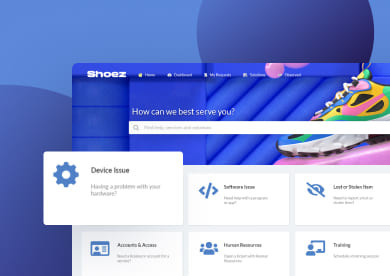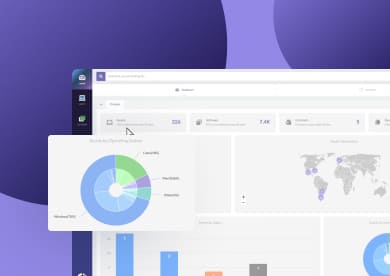An IT asset audit is a comprehensive evaluation of an organization's information technology assets. It involves identifying and assessing all IT assets to ensure they are accurately recorded, efficiently managed, and compliant with regulations.
In this article, we’ll break down what an IT asset audit is, how it differs from other types of audits, and walk you through a step-by-step guide to get it done right. Let’s dive in!
What is an IT asset audit?
An IT asset audit is a thorough examination of an organization's information technology assets, including hardware, software, and other IT resources.
This process aims to verify the existence, condition, and proper documentation of these assets, ensuring they are effectively managed and aligned with the organization's objectives.
It's important to distinguish an IT asset audit from an IT audit. While an IT asset audit focuses specifically on cataloging and assessing the organization's IT assets, an IT audit is a broader evaluation of the organization's IT systems, operations, and controls.
Why do you need to audit your IT assets?
Regular IT asset audits are essential for maintaining a robust and efficient IT infrastructure. They offer numerous advantages and help mitigate significant risks associated with neglecting this critical process.
Benefits of conducting regular IT asset audits
IT asset audits deliver multiple advantages that go beyond simply tracking hardware and software. They provide organizations with accurate data, reduce risks, and ensure resources are being used efficiently. Here are the key benefits you can expect.
#1. Keeps an accurate IT asset inventory
An IT asset audit ensures that every hardware, software, and IT resource is properly documented. By catching discrepancies, outdated records, or missing assets, organizations maintain a reliable inventory that supports daily operations and long-term planning.
#2. Optimizes IT asset utilization
Audits provide visibility into the condition, age, and depreciation of IT assets. This helps organizations schedule timely upgrades, replacements, or retirement plans, avoiding unexpected downtime and ensuring resources are used at their full potential.
#3. Contributes to compliance requirements
While an IT asset audit is not the same as a compliance audit, it provides the foundation for one. Accurate records of software licenses, asset configurations, and usage data make it easier to demonstrate compliance with regulations such as GDPR, HIPAA, or vendor license terms. Without this visibility, organizations risk failing a compliance review.
#4. Reduces risks
Regular audits reduce multiple types of risk. Beyond cybersecurity, they help prevent fines from expired licenses, legal issues from untracked software, or operational disruptions from overlooked end-of-life hardware.
#5. Optimizes costs
By uncovering underutilized, redundant, or unnecessary assets, audits prevent wasted spend and improve resource allocation. For instance, an audit may reveal dozens of software licenses that are being paid for but not actively used, allowing the organization to cut costs immediately.
#6. Enables strategic decision-making
Audits give leaders accurate data to align IT resources with business goals. Whether planning a cloud migration, budgeting for next year, or prioritizing security investments, decision-makers can rely on verified information rather than assumptions.

The IT asset audit process: 5-step plan
A successful IT asset audit follows a structured approach. Here’s a clear 5-step process you can adapt to your organization.
1. Set the foundation: Define the scope, objectives, and team
Start by defining what will be included in the audit — hardware, software, cloud assets, or all IT resources. Clarify the objectives, such as validating compliance, identifying gaps, or reducing costs.
Then, assemble a cross-functional team and assign roles and responsibilities to ensure accountability. A clear audit scope is essential to keep the process focused and aligned with business goals.
2. Prepare your tools and resources
The accuracy of an IT asset audit depends on the methods you use. While spreadsheets or manual checklists can work, most organizations benefit from dedicated IT asset audit software or IT Asset Management (ITAM) software.
Automated discovery, asset tags, barcode or QR code tagging, and lifecycle tracking can reduce errors, standardize data collection, and speed up the process.
3. Collect and verify asset data
This is the core of the audit process. For hardware, record key details such as make, model, serial number, location, purchase date, warranty status, and operational condition.
For software, build a complete inventory that includes versions, licenses, installation data, and usage metrics. Combine automated discovery with physical verification to catch discrepancies and ensure data accuracy.
4. Analyze findings and identify gaps
Once the data is collected, review it to detect inconsistencies, redundant assets, or compliance issues. Look for discrepancies between expected and actual asset records, underutilized resources, and expired licenses.
At this stage, it’s also useful to evaluate depreciation and lifecycle stages to plan replacements or upgrades before they disrupt operations.
5. Report, act, and plan for the next audit
Summarize the results in an audit report that highlights risks, discrepancies, and recommendations. Share findings with stakeholders in IT, finance, and leadership, then create an action plan to resolve issues.
Finally, schedule your next IT asset audit. Treating audits as a recurring process rather than a one-time task ensures long-term visibility and continuous improvement.
How InvGate Asset Management supports IT asset audits

InvGate Asset Management is a no-code ITAM software designed to simplify every stage of the audit process. It gives you complete visibility of your IT environment, automates manual tasks, and ensures your asset records are accurate and ready for reporting.
The platform is intuitive, easy to set up, and quick to start using — making it a strong fit whether you’re running your first IT asset audit or scaling to thousands of assets. With transparent pricing and flexible deployment, it grows with your organization while keeping costs predictable.
-
Automatically create a centralized IT asset inventory — Collect data through agents, network discovery, cloud integrations, or manual uploads to ensure nothing is left out of the audit.
-
Track every piece of hardware — Record condition, status, location, ownership, cost, and depreciation, plus track peripherals with QR codes and mobile scanning.
-
Track every piece of software — Monitor installations, license status, renewal dates, usage metrics, costs, and detect unauthorized software to stay compliant.
-
Automation and alerts — Send alerts for unauthorized software, update hardware status automatically with predefined rules, and receive reminders for renewals.
-
Custom reports and dashboards — Generate detailed audit reports, schedule their delivery, and use dashboards to visualize discrepancies and trends.
-
Integrate with well-known IT Service Management platforms — Connect asset data with ITSM workflows to link assets with incidents, changes, and requests for full traceability. InvGate Asset Management integrates seamlessly with ITSM tools, like InvGate Service Management, allowing you to automate processes end-to-end and keep both asset and service data in sync.
Ready to put it into practice? With InvGate Asset Management you can run your first IT asset audit in no time. Start your 30-day free trial today and see how simple it is to gain complete visibility and control over your IT assets.
5 best practices to start auditing your IT assets
1. Set clear objectives before you start
Every IT asset audit should begin with a defined purpose. Decide what you want to achieve — whether it’s validating compliance, identifying cost-saving opportunities, or updating outdated records. Clear objectives keep the audit focused and ensure the results are actionable.
2. Use dedicated IT asset audit software
Relying on spreadsheets or manual checklists increases the risk of errors and missing data. Instead, leverage IT asset audit software or a complete IT Asset Management software to automate discovery, asset tracking, and generate consistent reports. The right tool reduces human error, saves time, and ensures a reliable IT asset inventory.
3. Combine automated discovery with physical verification
Even with the best IT asset audit tools, physical checks are still necessary. Automated discovery can detect hardware and software across networks, but manual verification ensures accuracy, especially for peripherals, disconnected devices, or assets not tracked digitally. Combining both approaches creates a complete and accurate audit process.
4. Integrate audits into your IT Asset Management audit program
An IT asset audit should not be treated as a one-off task. Incorporating it into a broader IT Asset Management audit program ensures that audits are performed regularly, results are documented, and improvements are tracked over time. Using an IT Asset Management audit checklist can standardize the process and make it repeatable across cycles.
5. Turn audit findings into action plans
The value of an IT asset management audit comes from acting on the results. Use audit reports to identify underutilized assets, compliance gaps, or upcoming replacements, then create clear action plans with timelines. This transforms the audit from a compliance exercise into a driver of cost savings, risk reduction, and better decision-making.















